Introduction to Computational NeuroScience
Introduction
Computational neuroscience is the only field that can help you understand, how you're able to think and process information in your brain. Even by the time you finished this sentence, there will be a good number of actions happening inside your brain which can be decoded by the study of neurons. The ultimate goal of computational neuroscience is to explain how electrical and chemical signals are used in the brain to represent and process information. It explains the biophysical mechanisms of computation in neurons, computer simulations of neural circuits, and models of learning.

Before you start reading this article, there will be a few perceptions that your brain(you) might be considering, why do we need to read this? What can we learn from this? Or will this content let me know, how the brains react and solve problems in various situations? Yes! It's all the math, permutations, chemical equations happening inside our very own brains. This article is divided into three parts. In the first part of the article, we introduce computational neuroscience in brief which include, the role that neurons play, the anatomy of the neurons and the models that could be explained for the functionalities of the brain, so called, the brain models.
Now, let's see what all we can carry off by comprehending or by learning about a brain. Over the last few years, we've been seeing advancements in Neural Networks which are completely inspired by this "Computational neuroscience". The algorithms or models which are used in several areas of Neural Networks/ Computer Vision are derived by a theoretical understanding of neuroscience. All we know about our brains is, they are fast, intelligent, they take in input from the environments and some chemical reactions/fusions happen and finally, they give us the solution or the output. By reading this, you would get to know the execution of programs inside our brain. Let's get started!
This is the recent tweet that's posted by Lex Friedman. He works as a Research Scientist at MIT.
The human brain is incredible. Here visualized are 3% of the neurons and 0.0001% of the synapses in the brain, constituting part of the brain's Thalamocortical system. Visualization via DigiCortex Engine
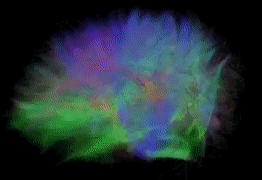
Neuroscience
Background
The term 'Computational neuroscience' was coined by Eric L. Schwartz, at a conference to provide a review of a field, which until that point was referred to by a variety of names, such as Neural modeling, Brain theory, and Neural Networks. Later, Hubel & Wiesel discovered the working of neurons across the retina, in the primary visual cortex (the first cortical area). This is explained in section 3. Further, with the rise in computational power, most computational neuroscientists collaborate closely with experimentalists in analyzing different data and synthesizing new models of biological phenomena.Theoretical neuroscience
Neuroscience encompasses approaches ranging from molecular and cellular studies to human psychophysics and psychology. The aim of computational neuroscience is to describe how electrical and chemical signals are used in the brain to interpret and process information. This intention is not new, but much has changed in the last decade. More is known now about the brain because of advances in neuroscience, more computing power is available for performing realistic simulations of neural systems, and new insights are being drawn from the study of simplified models of large networks of neurons.Understanding the brain is a challenge that is attracting a growing number of scientists, from many disciplines. Although there has been an explosion of discoveries over the last several decades concerning the structure of the brain at the cellular and molecular levels, we do not yet understand how the nervous system enables us to see, hear, learn, remember and plan certain actions. But there are numerous fields that depend on computational neuroscience, a few are listed below,
- Deep Learning, Artificial Intelligence and Machine Learning
- Human psychology
- Medical sciences
- Mental models
- Computational anatomy
- Information theory
Hubel and Wiesel Experiment
This experiment seems to be a harbinger for the neuronal insights that have been discovered. It has laid the foundation for exploring computational neuroscience in depth. Let's see what's inside thisProfessors David Hubel and Torsten Wiesel have experimented in the 1950s wherein they recorded the neuronal activities of the cat across the retina, as they moved a bright light. They've filed a few exciting observations while the experiment was going on, they are
- Neurons fired only in some instances, but not always.
- The activity of neurons changed depending on the orientation and location of the line of light
(Don't worry about the neuronal jargon, we would be exploring all the terms in the following topics.) The electrical and chemical signals recorded in the cells connecting the retina to the brain were converted to sound signals. These sound signals were then played, which resulted in 'Snap! Pop!' crackling sounds. These weren't continuous, instead played only when the neuron fired. Henceforth, it has established a fundamental understanding of how neurons extract the information cast by the retina, and then clearly explained how the visual cortical neurons (present in the primary visual cortex, V1, in the brain) can formulate an image.
Neural cells, Anatomy and Electrical Personality of neurons
So, to get a clear understanding of how the brain works and how we're able to perceive the world around us, let's look at the primary part of the brain, namely the neurons. These are the computational units of human brain.The brain can be broken down into individual discrete parts called neurons. There're many neuronal shapes possible, say, in the visual cortex, the neuron is pyramidal, and in the cerebellum, they are called the Purkinje cells.
Structure of neurons
A neuron consists of three main parts namely Soma, Dendrites, and Axon. Soma is the cell body. Dendrites are the input ends of the neurons whereas the axon is the output end. So, the input is received by the dendrites from the axons of the adjacent neuron. These inputs give rise to an Excitatory Post-Synaptic Potential (EPSP), and when taken as a combination from several other neurons, it provides an Action Potential or a Spike. This spiking happens only when the input reaches a certain threshold.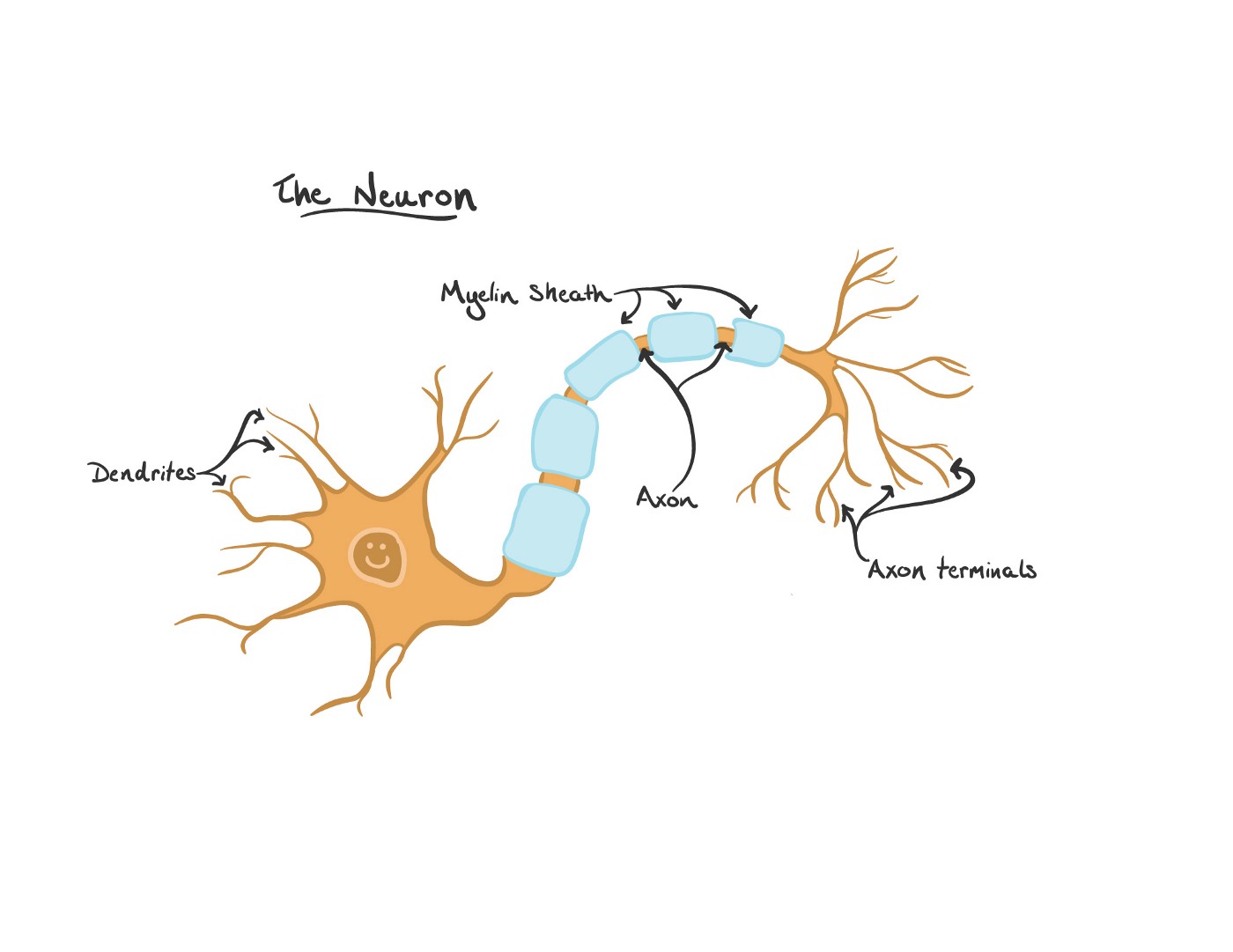
Peeking Inside
Interestingly, neurons can be defined as a "leaky bag of charged liquid." So, all of a sudden, how have chemicals cropped up? It's a crucial thing which many of us aren't aware of. Neurons deal entirely with chemicals, and chemical reactions drive all the spikes and synapses. We indeed have Na+, Cl-, K+, et al. in our brains. Fascinating, isn't it?Contents of a neuron are enclosed within a lipid bilayer, and the lipid is "fat" in simple terms. This bilayer is impermeable to charged ions, such as Na+, K+, Cl- et al. So, how do these chemicals move among the neurons? To answer this, let's deep dive into Ionic channels.
Ionic Channels
The "Ionic Channels" allow the transmission of these ions, i.e., to pass in and out of the neurons. This results in a Potential Difference which exists between the insides and the outer part of the neuron, the inside potential is -70mv relative to the outside.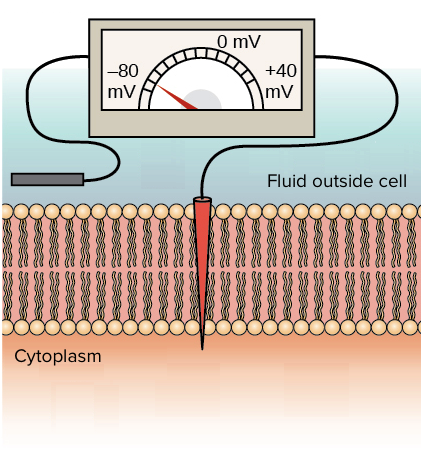
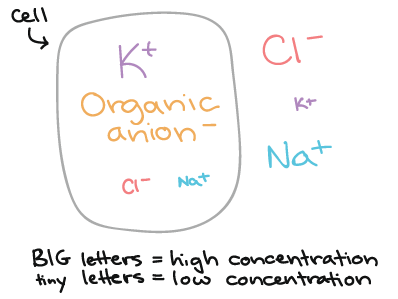
So, how's the potential always -70mv? This is maintained by pumping the ions in and out of the neurons, i.e., by expelling Na+ out and allowing K+ in. Ionic channels permit only specific neurons to pass and can be classified into three gated channels,
- Voltage-Gated - Probability of opening the channel depends on membrane voltage.
- Chemically Gated - Binding to a chemical causes the channel to open.
- Mechanically Gated - Pressure or stretch influences the channel to open/close.
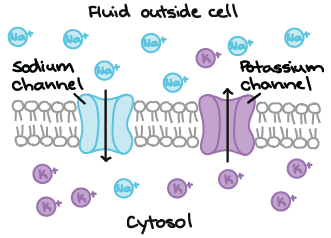
Neuronal signaling
Neuronal signaling is the interaction that happens among the neurons by the transmission of the signals. The gated channels discussed above allow for neuronal signaling, let's see how,- Firstly, the inputs from other neurons activate the chemically gated channels, i.e open the channels, which lead to changes in the local membrane potential.
- Next, this leads to the opening/closing of voltage-gated channels resulting in Depolarization(a positive change in voltage) and Hyperpolarization(a negative change in voltage). Repolarization is where the cell is brought back to the actual potential.
- A strong enough depolarisation will lead to the spike or the action potential.
- This indeed opens the Na+ channels(voltage-gated), followed by rapid Na+ influx(out to in) which drives more channels to open until they inactivate.
- When slowly the Na+ channels start to inactivate, K+ outflux(in to out) restores membrane potential or the K+ channels open, reducing the spike. This is Repolarization.
- Thereafter, the cell is made more negative as the K+ channels stay open and continue to let the positive ions exit the neuron. This is termed as Hyperpolarization.
- As the potassium channels close, the sodium-potassium pump works to reestablish the resting state again.
- After the spike is generated, it is propagated along the axon.
- Along the axon, Na+ channels open first, causing the rise of the Action Potential, followed by the closing of the Na+ channels and the opening of the K+ channels, which lead to the fall of Action Potential.
Graphically, this is how membrane potential is recorded as the time varies,
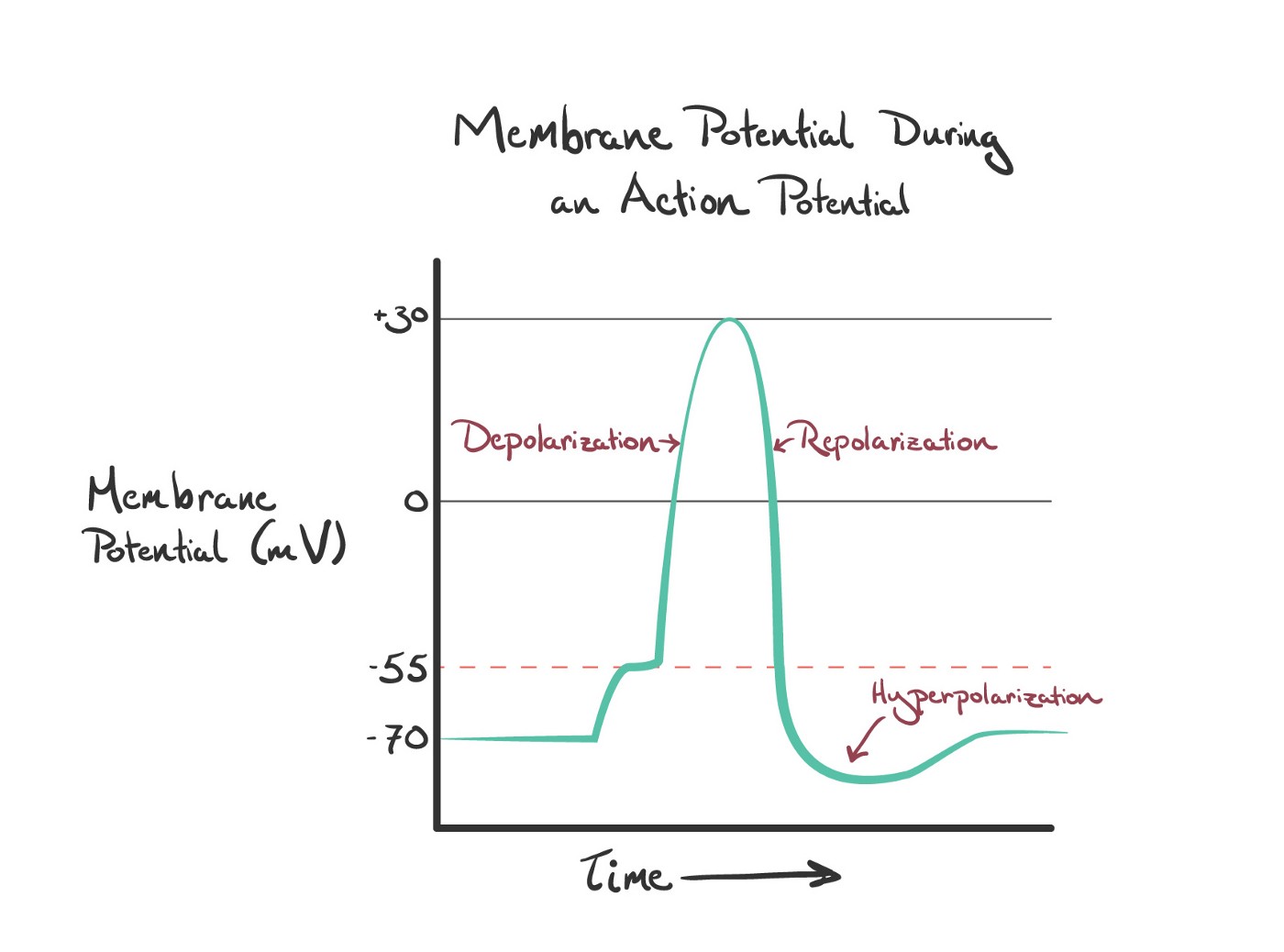
Velocity
Signals travel real quick along the axon mainly due to 2 reasons; size and Myelin Sheath. It's an insulating substance which doesn't allow ions to pass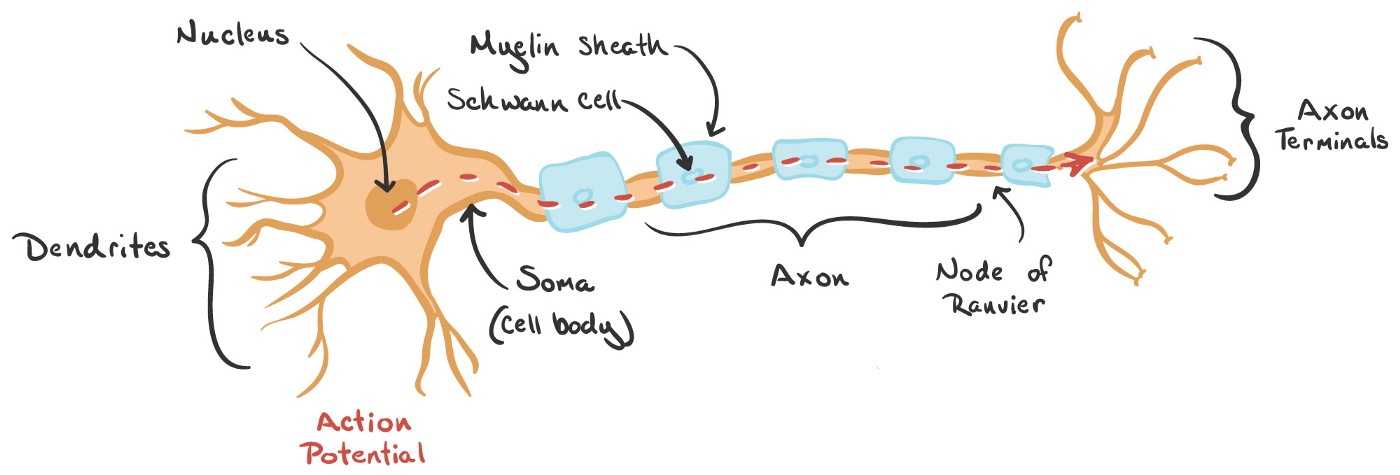
Peripheral Nervous System is made up of nerves and ganglia outside of the brain and the spinal cord. Central Nervous System consists of the brain and the spinal cord.
When action potential traverses through the axon, there are chances where it might get lost, so, the presence of myelin preserves it.
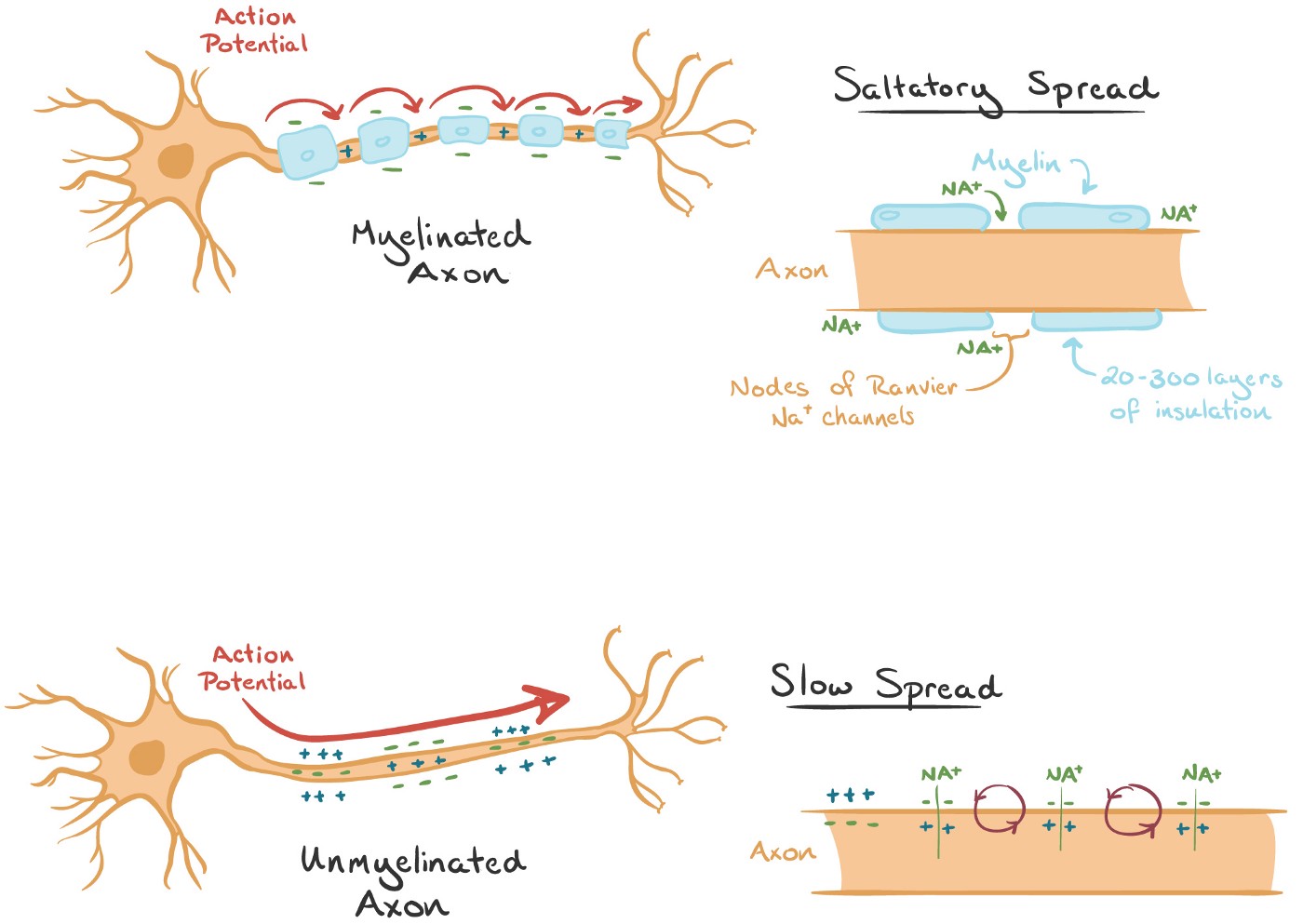
The nodes of ranvier have these positive gated voltage channels, where the positive ions form a swarm since they are the uncovered areas. So, the negative ions in the axons want to reach the nodes of ranvier to balance themselves. This propagation of the action potential looks like a signal jumping from node to node, termed as "Saltatory Conduction".
This also explains the shape of the spike, where it increases to a certain extent and then decreases.
Understanding Brain
Now that we have seen how neurons are structured and how they compute by sending signals and generating chemicals, it's now time to group a set of neurons to understand the brain. Understanding the brain is always a tricky question, sometimes we can't predict how people/brains react in a few scenarios, in spite of them indulging in routine activities. They store a lot of information inside neurons based on the actions they keep triggering. So the question here is, how do we need to interpret the information? There are three computational models to understand brains which explain the three questions, "What, How, and Why". These models are named as Descriptive, Mechanistic, and Interpretive models respectively. Now let's discuss in brief about these,Descriptive Models: This model answers the question "What are the neuronal responses to external stimuli?" They review large amounts of experimental data, thereby characterizing what neurons and neural circuits do. These models may be based loosely on Biophysical, Anatomical, and Physiological findings, but their primary purpose is to describe phenomena, not to explain them.
The two main properties of descriptive models are,
- They define qualitatively how to describe a scene or data by Neural Encoding.
- They also define how we can extract information from neurons by Neural Decoding techniques.
Mechanistic Models: Mechanistic models, on the other hand, address the question of "How nervous systems operate by known anatomy, physiology, and circuitry". Such models often form a bridge among descriptive models at different levels.
The two main properties of mechanistic models are,
- How can we simulate the behaviour of a single neuron on a computer?
- How do we simulate a network of neurons?
Interpretive Models: These use computational and information-theoretic principles to explore the behavioral and cognitive significance of various aspects of nervous system functionality, addressing the question of "Why nervous systems operate as they do".
The two main properties of interpretive models are,
- Why do brains operate the way they do?
- What are the computational principles underlying them?






